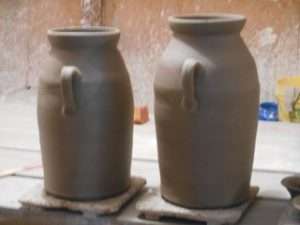The cluster of three mounds known as the Hamilton Mounds site is the largest indigenous mound site in Marion County, Alabama. The site includes three mounds along the left bank of the Buttahatchee River: a large mound (Mound A) with a two tiered summit, another smaller two tiered mound (Mound C) and a yet smaller mound (Mound B) situated between the two. The mounds’ major occupation occurred during the Mississippian Stage (AD 1250 – 1500) when such monumental sites served as both residential and cultural centers where people in the surrounding river valleys could come together, much like our modern towns and cities.
Most Mississippian mounds were built in stages as part of renewal ceremonies that included clearing the old mound, adding additional fill to increase the overall size, and building new structures. Archaeologists believe the mounds were initially built during the Early Mississippian period when people were first transitioning to new ways of life and using new types of tools and manufacturing techniques for pottery. This new culture was strongly influenced by people and ideas that had their origins in the Mississippi River Valley, but that moved east and become the dominant culture of Tombigbee and the adjacent Black Warrior and Tennessee River Valleys. The pottery and other artifact styles found here were culturally tied to the massive Mississippian mound complex of Moundville, located about twenty miles south of present-day Tuscaloosa.
The major occupation of the site likely dates to around AD 1250, when sites like Lubbub Creek and the Kellog site were large busy villages downstream along the Tombigbee and smaller farmsteads like the Tibbee Creek site dotted the surrounding floodplains. Some of these sites were fortified, with protective encircling palisade walls, while others were not. Agriculture was a major part of the lives of the Mississippian peoples who lived in the Southeast and those who built the Hamilton Mounds likely relied heavily on growing corn, beans, and squash in the rich bottomlands of the Buttahatchee River.
This site is very important to numerous Southeastern indigenous tribes who assert an ancestral connection with those who built and occupied Alabama’s ancient mounds. The earthwork landscapes and the objects and information recovered from them reveal a rich cultural tradition that still thrives today among these tribes. Our indigenous mound sites represent a heritage for all Alabamians to cherish, and it is important that we protect and preserve them for future generations.




